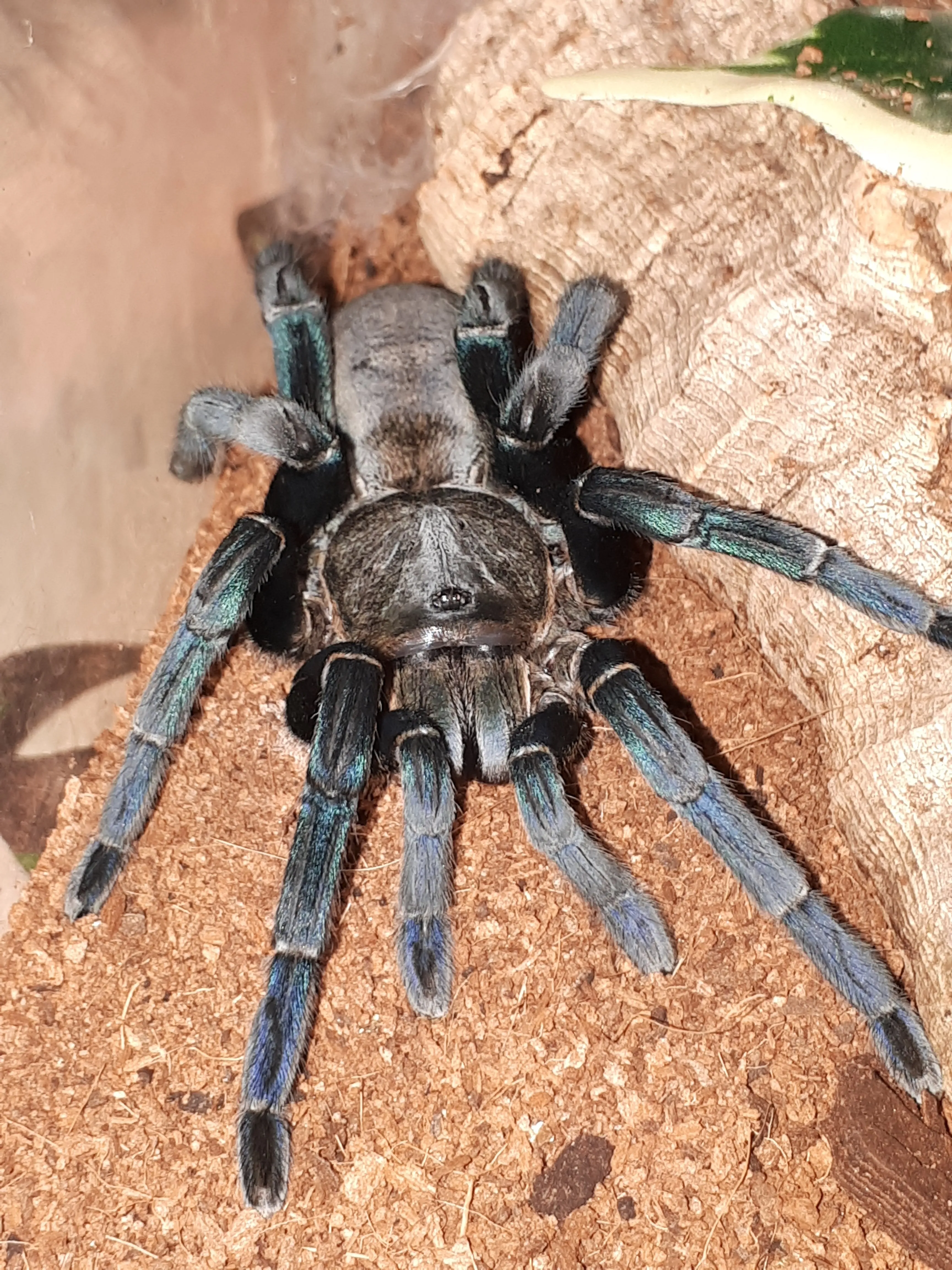What is a Cobalt Blue Tarantula
The Cobalt Blue Tarantula (Cyriopagopus lividus) is a captivating species that has gained popularity among tarantula enthusiasts. Known for its striking metallic blue coloration, this tarantula is native to the tropical forests of Myanmar and Thailand. Its vibrant hue and relatively docile nature make it a sought-after pet, but potential owners must be well-informed about its specific needs. Understanding this species involves learning about its physical characteristics, habitat, behavior, and the care it requires to thrive. These tarantulas are not only visually stunning but also offer a fascinating glimpse into the world of arachnids. This article will delve into the unique aspects of Cobalt Blue Tarantulas, providing essential facts for anyone interested in these amazing creatures.
Appearance & Characteristics of Cobalt Blue Tarantula
The Cobalt Blue Tarantula is renowned for its stunning appearance. The most distinctive feature is its metallic blue coloration, which is most vibrant on the legs and carapace. This vibrant blue hue is not just a random display of color, it helps them blend into their surroundings, particularly in their natural habitat of tropical forests. The abdomen is typically a darker shade, often with subtle patterns that contrast with the bright blue legs. The overall appearance is compact and robust. The combination of its vibrant colors and sturdy build makes it one of the most visually striking tarantulas in the hobby.
Distinctive Blue Color
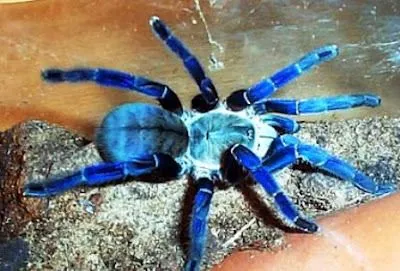
The unique cobalt blue color is due to pigments and structural coloration, with iridescence effects, giving them their vibrant appearance. This vivid coloration sets them apart from many other tarantula species and adds to their appeal. The blue color is most intense in the juveniles and can fade slightly with age, but it remains a distinctive feature throughout their lives. The specific shade of blue can vary slightly from one individual to another, but it always remains a striking and recognizable characteristic of this species, making them a favorite among collectors.
Size and Lifespan
Cobalt Blue Tarantulas are considered a medium-sized tarantula species. Females typically reach a leg span of about 5–6 inches, while males are usually slightly smaller. Their lifespan varies depending on the gender, with females living significantly longer than males. Females can live for 12–15 years or longer with proper care, while males typically live for 3–5 years after reaching maturity. The difference in lifespan is a common characteristic among tarantula species. This extended lifespan makes them a long-term commitment, and owners should be prepared to care for them for many years.
Habitat and Distribution
Cobalt Blue Tarantulas are native to Southeast Asia, specifically found in the tropical rainforests of Myanmar and Thailand. They thrive in warm, humid environments, where they create burrows or find shelter under rocks and logs. Understanding their natural habitat is crucial for replicating their environment in captivity. Preserving their natural habitat is also important for ensuring the long-term survival of this species in the wild. Proper care in captivity should mimic their natural habitat to ensure the tarantula’s health and happiness.
Native Range and Environment
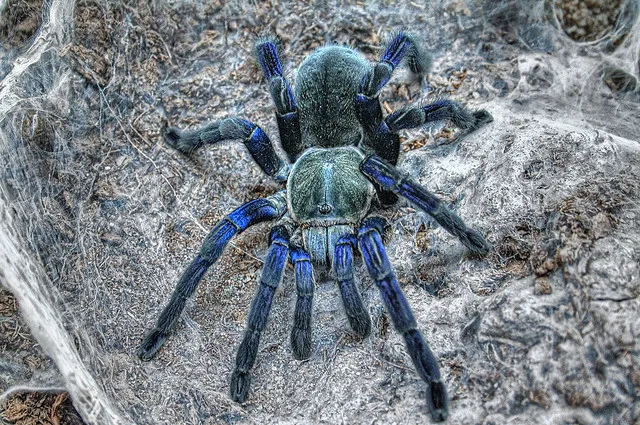
The native environment of the Cobalt Blue Tarantula consists of dense tropical forests with high humidity and temperatures. They are well-adapted to this climate. They often inhabit areas with plenty of leaf litter and undergrowth, which provides cover and helps maintain humidity levels. Understanding these environmental conditions is key to providing appropriate care in a captive setting. The natural conditions are also critical for their burrowing behavior, and it allows the tarantula to thrive in the wild.
Burrowing Behavior
Cobalt Blue Tarantulas are known for their burrowing behavior. In their natural habitat, they dig burrows in the soil or utilize existing shelters like fallen logs and crevices. This behavior helps them regulate their body temperature, hide from predators, and ambush prey. In captivity, providing a deep substrate is essential to allow them to engage in this natural behavior. This allows them to feel more secure and reduces stress. This burrowing behavior is a fundamental aspect of their natural instincts, and it enriches their life in captivity.
Interesting Facts
The Cobalt Blue Tarantula offers a fascinating glimpse into the world of arachnids, showcasing their survival strategies. These creatures possess unique adaptations. They are venomous, they use their defensive mechanisms, and their feeding habits reflect their predatory nature. Molting is a unique biological process. These aspects highlight their unique place in the ecosystem.
Venom and Bite
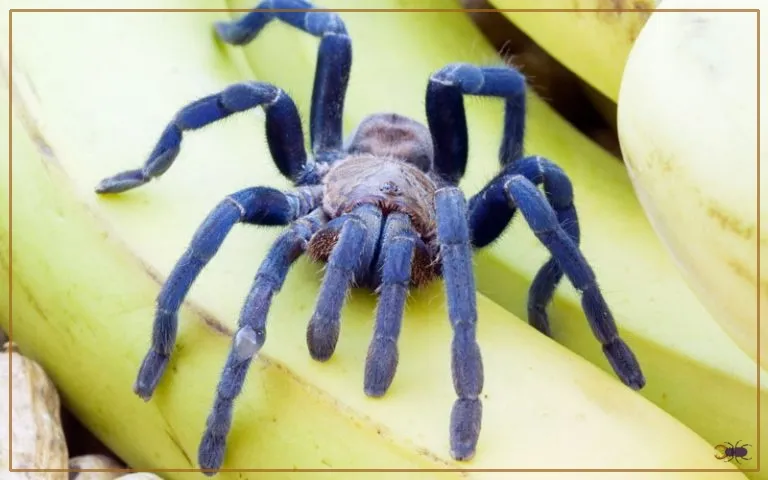
Like all tarantulas, the Cobalt Blue Tarantula is venomous. While their venom is not considered lethal to humans, their bite can be painful, causing localized pain, swelling, and muscle cramps. The severity of the reaction varies from person to person. They are generally not aggressive and will only bite if they feel threatened. Their fangs are large and capable of delivering a painful bite. It is crucial to handle them with care and avoid any actions that might provoke them.
Defensive Mechanisms
In addition to their bite, Cobalt Blue Tarantulas have other defensive mechanisms. They can flick urticating hairs from their abdomen if they feel threatened. These hairs are irritating to skin and can cause itching and discomfort. They also have the ability to raise their front legs and display their fangs as a warning. They may try to escape or run away. These defense mechanisms are part of their survival strategy. Owners should be aware of these behaviors and take appropriate precautions.
Feeding Habits
Cobalt Blue Tarantulas are opportunistic predators, feeding primarily on insects. Their diet in the wild consists of whatever prey they can capture. Their feeding behavior is influenced by factors such as their stage of development, health, and the availability of food. In captivity, providing a varied diet is essential to maintain their health. Their predatory nature is a fundamental aspect of their behavior, which is important to understand for proper care.
Diet in the Wild
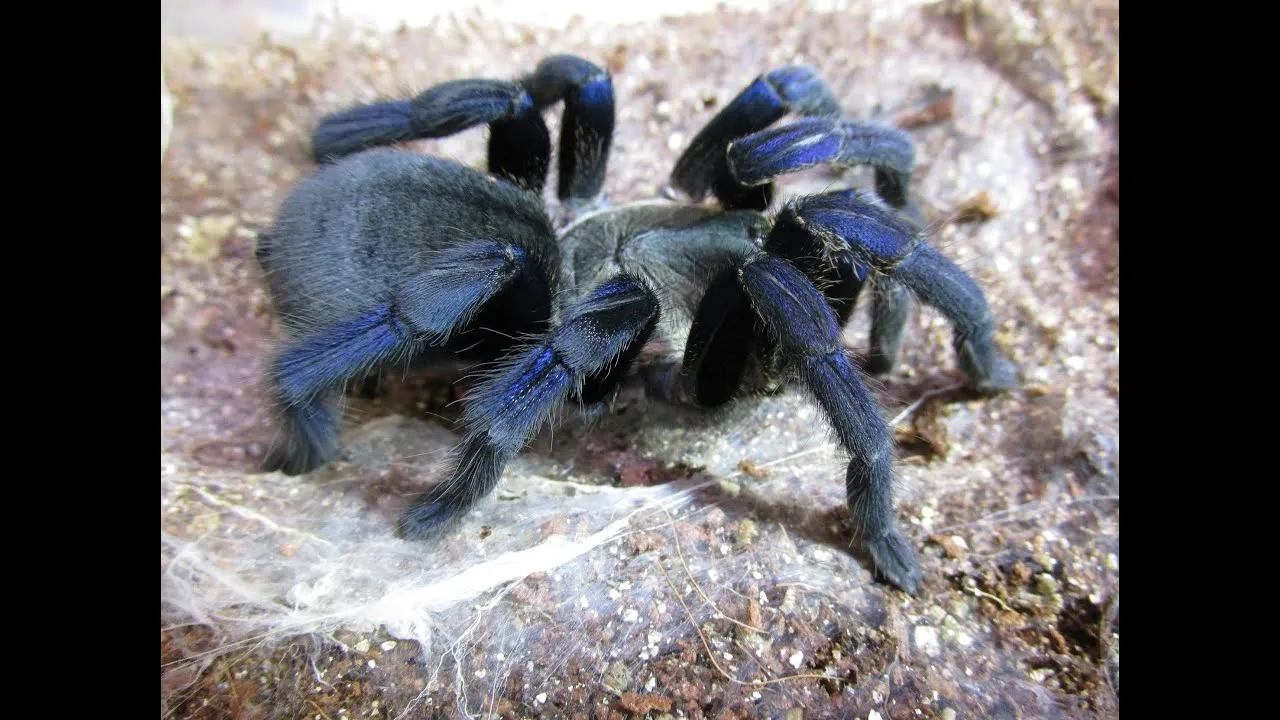
In their natural habitat, Cobalt Blue Tarantulas consume a variety of insects, including crickets, grasshoppers, and other invertebrates. They are skilled hunters, ambushing their prey from their burrows or using their venom to subdue them. They also eat other arthropods such as small spiders and millipedes. Their diet reflects the available food sources in their environment, and they can adapt to different types of prey depending on what is available. The variety of insects ensures they get all the necessary nutrients.
Diet in Captivity
In captivity, the Cobalt Blue Tarantula’s diet should consist mainly of insects, such as crickets, mealworms, and cockroaches. These insects should be gut-loaded before being fed to the tarantula. Gut loading involves feeding the insects nutritious food. This ensures that the tarantula receives a balanced diet. Providing a variety of food ensures that the tarantula receives the essential nutrients needed for growth and health. Food should be appropriately sized to ensure they are not too small or too large.
Molting Process
Molting is a critical process in a tarantula’s life, allowing it to grow and shed its exoskeleton. During molting, the tarantula sheds its old exoskeleton, revealing a new, larger one. This process is crucial for growth and is a vulnerable time for the tarantula. Understanding the molting process and providing appropriate care is essential for the tarantula’s well-being. The molting process helps to eliminate parasites. The process also regenerates lost limbs.
Frequency and Stages

The frequency of molting depends on the tarantula’s age, growth rate, and environmental conditions. Young tarantulas molt more frequently than adults, often every few months. As they mature, the molting frequency decreases, with adults molting once or twice a year. The molting process involves several stages, including pre-molt, the actual molt, and post-molt. In the pre-molt phase, the tarantula may appear lethargic and stop eating, and the abdomen color will darken. During the molt, the tarantula sheds its old exoskeleton. It will then be very soft and vulnerable.
Impact of Molting
Molting is a stressful but essential process. It allows the tarantula to grow larger and replace damaged parts. During the post-molt phase, the tarantula’s new exoskeleton is soft and vulnerable. It is important not to disturb the tarantula during this time. Once the new exoskeleton hardens, the tarantula will resume its normal activities. Proper humidity and temperature levels are crucial during this time to ensure the molting process is successful.
Care and Keeping of Cobalt Blue Tarantula
Caring for a Cobalt Blue Tarantula involves creating an appropriate habitat. Proper housing, temperature, and humidity are essential for their health and well-being. A key aspect is providing a safe environment where they can thrive. Learning about their specific needs ensures a long, healthy life for these captivating creatures. Responsible ownership involves understanding their behavior and providing everything they need to thrive in captivity.
Housing Requirements

The appropriate enclosure size depends on the tarantula’s size. A juvenile tarantula can be housed in a smaller enclosure, such as a 5–10 gallon tank. Adult females will need a larger enclosure. A 10–20 gallon tank or a similar-sized terrarium is suitable. The enclosure should have a secure lid to prevent escape. The ventilation is essential to maintain proper humidity. Substrate is an important consideration; a deep layer of substrate should be used. This allows for burrowing. Adequate space is essential for proper growth and well-being.
Terrarium Setup
The terrarium setup should mimic the tarantula’s natural habitat. Use a substrate that is suitable for burrowing, such as a mixture of coconut fiber, peat moss, and vermiculite. The substrate should be deep enough for the tarantula to dig a burrow, typically 6–8 inches deep. Provide a hide, such as a piece of cork bark or a hollow log. This gives the tarantula a place to retreat and feel secure. Add some live or artificial plants to provide cover and help maintain humidity. The substrate needs to be kept moist, but not wet.
Temperature and Humidity
Maintaining the correct temperature and humidity levels is crucial for the tarantula’s health. The ideal temperature range is between 75–85°F (24–29°C). You can use a heat pad or a low-wattage heat lamp to maintain the appropriate temperature. The humidity should be kept at 70–80%. You can measure humidity with a hygrometer. Regular misting or a shallow water dish is used to increase humidity. These conditions are the same as their natural environment. Providing proper temperature and humidity ensures that the tarantula will thrive.
Feeding & Hydration
Feeding and providing fresh water are essential aspects of tarantula care. The frequency of feeding depends on the age and size of the tarantula. Ensure that the tarantula has access to fresh water at all times. Providing the correct amount of food and water ensures the tarantula receives the necessary nutrients and stays hydrated.
Food and Water
Feed juvenile tarantulas two to three times a week. Adult tarantulas need to be fed once or twice a week. The food should consist of appropriately sized insects. Crickets, mealworms, and cockroaches are good choices. Ensure the insects are gut-loaded before feeding. This will improve the nutritional value. A shallow water dish should always be available for the tarantula to drink from. The water dish should be cleaned regularly to prevent bacterial growth. Providing food and water ensures the tarantula remains well-fed and hydrated.
Handling and Safety
Handling a Cobalt Blue Tarantula requires caution and knowledge. While they are generally not aggressive, they can bite if they feel threatened. Understanding their behavior and practicing safe handling techniques is essential for avoiding injury to both the tarantula and the handler. When handling, always stay alert to the tarantula’s behavior. Always be prepared for sudden movement. These are some of the things that will help prevent injury.
Safe Handling Practices
If you choose to handle a Cobalt Blue Tarantula, do so with great care. Handle them as little as possible. When handling is necessary, do so over a soft surface, such as a bed or carpet, to minimize the risk if the tarantula falls. Avoid sudden movements and ensure the tarantula feels secure. Never grab the tarantula or force it to move. Instead, gently encourage it to walk onto your hand. Be aware of their defensive behaviors and be prepared to react if the tarantula shows signs of stress or aggression. Always wash your hands before and after handling.
Risks and Precautions
There are certain risks associated with handling Cobalt Blue Tarantulas. Their bite can be painful. They can also flick urticating hairs, causing skin irritation. Avoid handling if you are allergic to insect bites. Keep the tarantula away from children. Always supervise children when they are near the tarantula’s enclosure. If bitten, seek medical attention if symptoms are severe. Know the risks involved and take the necessary precautions to minimize them.
Conclusion
The Cobalt Blue Tarantula is a captivating species that can be a rewarding pet for those who are well-informed and prepared. Understanding their unique characteristics, habitat requirements, and care needs is essential for their well-being. By providing a suitable environment, a balanced diet, and practicing safe handling, owners can ensure that their Cobalt Blue Tarantulas live long and healthy lives. Responsible ownership includes a commitment to learning about these amazing creatures and respecting their natural behaviors. The Cobalt Blue Tarantula’s striking appearance and interesting behaviors will continue to captivate and inspire many people.
